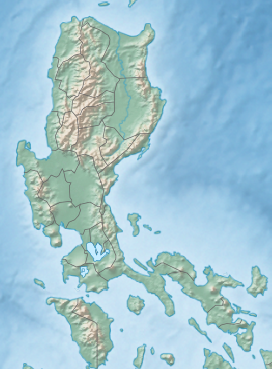| Mount Pulag | |
|---|---|
 Sea of clouds near Mount Pulag summit | |
| Highest point | |
| Elevation | 2,928 m (9,606 ft)[1][2] |
| Prominence | 2,928 m (9,606 ft)[2] Ranked 107th |
| Listing | |
| Coordinates | 16°35′0.86″N 120°53′0.93″E / 16.5835722°N 120.8835917°E |
| Geography | |
| Location | Luzon |
| Country | Philippines |
| Regions | Cordillera Administrative Region and Cagayan Valley |
| Provinces | Benguet, Ifugao and Nueva Vizcaya |
| Municipalities | Bokod, Kabayan, Kayapa and Tinoc |
| Parent range | Cordillera Central |
| Geology | |
| Mountain type | Dormant volcano |
| Volcanic arc | Luzon Volcanic Arc |
| Climbing | |
| First ascent | c. 2000 BC by the native Ibalois. |
| Easiest route | Ambangeg Trail |
Mount Pulag (Filipino: Bundok Pulag; Ilocano: Bantay Pulag)[3] is Luzon's highest peak at 2,928 metres (9,606 ft) above sea level, third-highest mountain in the Philippines, and the 26th-highest peak of an island on Earth.
It is second-most prominent mountain in the Philippines, it is a dormant volcano. Located on the triple border of the provinces of Benguet, Ifugao, and Nueva Vizcaya, the borders meet at the mountain's peak. Mount Pulag is third highest next to Mount Apo and Mount Dulang-dulang.[4]
Mount Pulag is famous for its "sea of clouds" and its exceptional view of the Milky Way Galaxy at dawn, which has attracted many tourists who wish to see the "other-worldly" scenery.
The entire mountain is believed to be the home to the tinmongao spirits and is the sacred resting ground of the souls of the Ibaloi people and other ethnic peoples in the area.[5]
- ^ a b "Inactive Volcanoes; Part 6". Philippine Institute of Volcanology and Seismology. July 30, 2008. Archived from the original on March 22, 2016. Retrieved March 24, 2016.
- ^ a b de Ferranti, Jonathan; Maizlish, Aaron. "Philippine Mountains – 29 Mountain Summits with Prominence of 1,500 Meters or Greater". Archived from the original on February 17, 2015. Retrieved January 31, 2011.
- ^ "Highest Mountains of the Philippines!". Tagalog Lang. July 25, 2015. Archived from the original on January 23, 2022. Retrieved November 10, 2019.
- ^ Lasco, Gideon (January 24, 2016). "The 10 Highest Mountains in the Philippines (2016 Update)". Pinoy Mountaineer. Archived from the original on January 22, 2018. Retrieved January 22, 2018.
- ^ "Benguet Folk to Appease Mount Pulag Spirits". The Manila Times. Archived from the original on September 21, 2019. Retrieved November 10, 2019.

